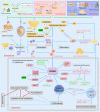Research advances in intramuscular fat deposition and chicken meat quality: genetics and nutrition
- PMID: 40665461
- PMCID: PMC12265352
- DOI: 10.1186/s40104-025-01234-5
Research advances in intramuscular fat deposition and chicken meat quality: genetics and nutrition
Abstract
Chicken meat quality directly influences consumer acceptability and is crucial for the economic success of the poultry industry. Genetics and nutrition are key determinants of the meat quality traits in broilers. This review summarizes the research advances in this field, with a focus on the genetic and nutritional foundations that regulate intramuscular fat (IMF) deposition and meat quality in chickens over the past decade. The effects of embryonic nutrition, both maternal nutrition and in ovo feeding (IOF), on skeletal muscle development, the IMF content, and meat quality traits in broilers are also discussed. In genetics, single-cell RNA sequencing revealed that de novo lipogenesis predominantly occurs in myocytes, which is key to the formation of IMF in chicken muscle tissue. Fatty acid synthase (FASN) is the key enzyme involved in this process. This discovery has reshaped the traditional understanding of intramuscular lipid metabolism in poultry. Key genes, proteins, and pathways, such as FASN, FABP4, PPARG, C/EBPα, SLC27A1; LPL, APOA1, COL1A1; PPAR and ECM-receptor interactions signaling, have been identified to regulate IMF content and distribution by modulating fatty acid metabolism and adipogenesis. LncHLFF was innovatively found to promote ectopic IMF deposition in chickens via exosome-mediated mechanisms without affecting abdominal fat deposition. MiR-27b-3p and miR-128-3p were found to inhibit adipogenic differentiation by targeting PPARG, thereby affecting IMF formation. In nutrition, nutrigenomics research has shown that fructose enhances IMF deposition by activating ChREBP, providing new targets for nutritional interventions. Adjusting dietary components, including energy, protein, amino acids, fatty acids, and phytochemicals (e.g., rutin), has been shown to significantly improve meat quality in broilers. Maternal nutrition (e.g., intake of energy, amino acids, vitamins, and trace elements) and IOF (e.g., N-carbamylglutamate) have also been confirmed to significantly impact offspring meat quality, opening new avenues for improving embryonic nutrition. Based on these significant advancements, this review proposes strategies that integrate genetic and nutritional approaches. These strategies aim to modulate the differentiation fate of paraxial mesenchymal stem cells toward myogenic or adipogenic lineages and the interaction between muscle and adipose tissues. These insights would help to improve meat quality while ensuring the growth performance of broiler chickens.
Keywords: Chicken meat quality; Embryonic nutrition; Genetic regulation; Intramuscular fat; Nutritional intervention.
© 2025. The Author(s).
Conflict of interest statement
Declarations. Ethics approval and consent to participate: Not applicable. Consent for publication: Not applicable. Competing interests: The authors declare no conflict of interest.
Figures






Similar articles
-
Exploring the impact of fatty acid composition on carcass and meat quality in Bos taurus indicus influenced cattle.J Anim Sci. 2024 Jan 3;102:skae306. doi: 10.1093/jas/skae306. J Anim Sci. 2024. PMID: 39383295
-
Enhancing skeletal muscle fiber characteristics, intramuscular fat deposition, and fatty acid composition in broilers under heat stress through combined selenomethionine and Bacillus subtilis supplementation in the diet.J Anim Sci. 2024 Jan 3;102:skae267. doi: 10.1093/jas/skae267. J Anim Sci. 2024. PMID: 39301922
-
Bivariate GWAS performed on rabbits divergently selected for intramuscular fat content reveals pleiotropic genomic regions and genes related to meat and carcass quality traits.Genet Sel Evol. 2025 Jul 11;57(1):36. doi: 10.1186/s12711-025-00971-5. Genet Sel Evol. 2025. PMID: 40646437 Free PMC article.
-
Management of urinary stones by experts in stone disease (ESD 2025).Arch Ital Urol Androl. 2025 Jun 30;97(2):14085. doi: 10.4081/aiua.2025.14085. Epub 2025 Jun 30. Arch Ital Urol Androl. 2025. PMID: 40583613 Review.
-
The Black Book of Psychotropic Dosing and Monitoring.Psychopharmacol Bull. 2024 Jul 8;54(3):8-59. Psychopharmacol Bull. 2024. PMID: 38993656 Free PMC article. Review.
References
-
- Petracci M, Mudalal S, Soglia F, Cavani C. Meat quality in fast-growing broiler chickens. Worlds Poult Sci J. 2015;71(2):363–74. 10.1017/S0043933915000367.
-
- Our world in data. 2024. https://ourworldindata.org/. Accessed 20 Jan 2025.
-
- Cui HH. The research on molecular regulatory network and gen related intramuscular fat deposition in chicken. Dissertation/doctoral thesis, Chinese Academy of Agricultural Sciences, Beijing, China, 2011.
Publication types
Grants and funding
LinkOut - more resources
Full Text Sources
Research Materials
Miscellaneous

